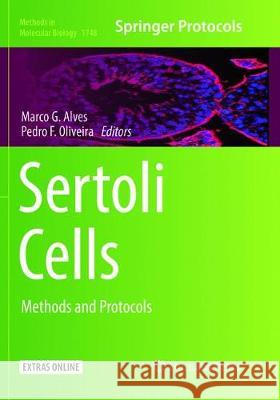


ISBN-13: 9781493985432 / Angielski / Miękka / 2019 / 297 str.
ISBN-13: 9781493985432 / Angielski / Miękka / 2019 / 297 str.
"The pictures illustrating the book are all of high quality and the readers will be satisfied and certainly not disappointed while running through the chapters: exactly in the same manner you cannot stop of eating chapters or cherries, one is calling the other!" (CarloAlberto Redi, European Journal of Histochemistry, Vol. 63 (01), 2019)
1. Establishment of Primary Culture of Sertoli Cells
Raquel L. Bernardino, Marco G. Alves, and Pedro F. Oliveira
2. Evaluation of the Purity of Sertoli Cell Primary Cultures
Raquel L. Bernardino, Marco G. Alves, and Pedro F. Oliveira
3. Preparation of Testicular Samples for Histology and Immunohistochemistry
Barbara Bilinska, Anna Hejmej, and Malgorzata Kotula-Balak
4. Rabbit Sertoli Cells: Immunohistochemical Profile from Neonatal to Adult Age
Valeria Grieco and Barbara Banco
5. Identification of Proliferative and Apoptotic Sertoli Cells Using Fluorescence and Confocal Microscopy
Jesús Martínez-Hernández, Vicente Seco-Rovira, Ester Beltrán-Frutos, Victor Quesada-Cubo, Concepción Ferrer, and Luis Miguel Pastor
6. Sertoli Cells Preparation for Co-Immunoprecipitation
Maria João Freitas and Margarida Fardilha
7. Profiling Signaling Proteins in Sertoli Cells by Co-Immunoprecipitation
Maria João Freitas and Margarida Fardilha
8. Phagocytosis by Sertoli Cells: Analysis of Main Phagocytosis Steps by Confocal and Electron Microscopy
Marina G. Yefimova, Nadia Messaddeq, Annie-Claire Meunier, Anne Cantereau, Bernard Jegou, and Nicolas Bourmeyster
9. A Method for In Vivo Induction and Ultrastructural Detection of Mitophagy in Sertoli Cells
Nabil Eid, Yuko Ito, Akio Horibe, Hitomi Hamaoka, and Yoichi Kondo
10. Assessing Autophagy in Sertoli Cells
Chao Liu, Jehangir Khan, and Wei Li
11. Molecular Mechanisms and Signaling Pathways Involved in the Nutritional Support of Spermatogenesis by Sertoli Cells
Luís Crisóstomo, Marco G. Alves, Agostina Gorga, Mário Sousa, María F. Riera, María N. Galardo, Silvina B. Meroni, and Pedro F. Oliveira
12. Assessing Sertoli Cells Metabolic Activity
Ivana Jarak, Pedro F. Oliveira, Gustavo Rindone, Rui Carvalho, María Noel Galardo, María Fernanda Riera, Silvina Meroni, and Marco G. Alves
13. Proteome Profiling of Sertoli Cells Using a GeLC-MS/MS Strategy
Rita Ferreira, Fábio Trindade, and Rui Vitorino
14. Gene Silencing of Human Sertoli Cells Utilizing Small Interfering RNAs
Hong Wang, Qingqing Yuan, Minghui Niu, Liping Wen, Hongyong Fu, Fan Zhou, Weihui Zhang, and Zuping He
15. Testicular Cell Selective Ablation Using Diphtheria Toxin Receptor Transgenic Mice
Diane Rebourcet, Annalucia Darbey, Michael Curley, Peter O’Shaughnessy, and Lee B. Smith
16. Regulation of Blood-Testis Barrier (BTB) Dynamics, Role of the Actin, and Microtubule-Based Cytoskeletons
Qing Wen, Elizabeth I. Tang, Nan Li, Dolores D. Mruk, Will M. Lee, Bruno Silvestrini, and C. Yan Cheng
17. Monitoring the Integrity of the Blood-Testis Barrier (BTB): An In Vivo Assay
Haiqi Chen, Wing-yee Lui, Dolores Mruk, Xiang Xiao, Renshan Ge, Qingquan Lian, Will M. Lee, Bruno Silvestrini, and C. Yan Cheng
18. Computational Methods Involved in Evaluating the Toxicity of the Reproductive Roxicants in Sertoli Cell
Pranitha Jenardhanan, Manivel Panneerselvam, and Premendu P. Mathur
19. A Stopped-Flow Light Scattering Methodology for Assessing the Osmotic Water Permeability of Whole Sertoli Cells
Anna Maggio, Raquel L. Bernardino, Patrizia Gena, Marco G. Alves, Pedro F. Oliveira, and Giuseppe Calamita
20. Cryopreservation of Human Testicular Tissue by Isopropyl-Controlled Slow Freezing
Yoni Baert, Jaime Onofre, Dorien Van Saen, and Ellen Goossens
This detailed volume explores the use of Sertoli cells as models in male reproductive biology or as supporters for other cell types, and it answers the need for standardized protocols for their in vitro culture. Prepared for non-specialists as well as experienced researchers that may be interested in a multidisciplinary approach to study these cells, the book examines these remarkable cells that present some unique features that go far beyond the physical and nutritional support of spermatogenesis. Written for the highly successful Methods in Molecular Biology series, chapters include introductions to their respective topics, lists of the necessary materials and reagents, step-by-step, readily reproducible laboratory protocols, and tips on troubleshooting and avoiding known pitfalls.
1997-2024 DolnySlask.com Agencja Internetowa







